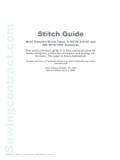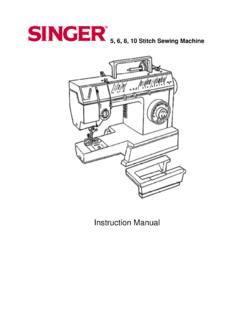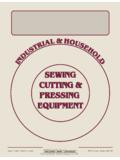Transcription of Sewingcontract - TexUp
1 Stitch Guide Most Common Stitch Types in ASTM D-6193 and ISO 4915:1991 StandardsThis quick reference guide is to help communication be-tween designers, production managers and sewing con-tractors. The guide is freely courtecy of , , Edition October 17, 2007 Second Editon June 3, LLC, Helsinki, TexUp O , Estonia, Wapductions Inc. New # 101 ChainstitchStitch formed by a needle thread passing through the material and interlooping with itself on the underside of the seam. ISO# 103 BlindstitchStitch is formed with one needle thread which interloops with itself on the top surface of the ma-terial.
2 The thread passes through the top ply and horizontally through portions of the bottom ply. ISO# 301 LockstitchStitch formed by a needle thread passing through the material and interlocking with a bobbin thread. Threads are meeting in the center of the seam. Stitch appear the same on the top as well as the bottom. ISO# 301 Twin Needle LockstitchSame s 301 except that two rows of stitch are formed. Common needle spacing is 1/4 (6mm) however, the machines are available from 3/16 up to 1 (6-25mm)ISO# 304 Zig ZagLockstitch is formed with a needle and bobbin thread forming a symmetrical zig zag pattern.
3 This stitch is also used in bartacking and lockstitch buttonsewing and buttonholing. ISO# 401 -ChainstitchStitch formed by 1 needle thread and being interlooped with 1 looper thread that is set on the underside of the seam. ISO# 401 Twin Needle ChainstitchStitch formed by 2 needle threads being inter-looped with 2 looper threads, forming 2 indepen-dent rows of stitch # 406 Bottom CoverstitchStitch formed by 2 needle threads passing through the material and interlooping with 1 looper thread with the stitch set on the underside of the seam.
4 Looper thread interlooped between needle threads, providing seam coverage on the bottom side. ISO# 407 Bottom CoverstitchStitch formed by 3 needle threads passing through the material and interlacing with 1 looper thread with the stitch set on the underside of the seam. Looper thread is interlooped between needle threads, providing seam coverage on the bottom side only. 304301401406103407 ASTM D-6193 ISO104 BlindstitchOne thread Blinstitch for hemming, See page 4 Dewellton LLC, Helsinki, TexUp O , Estonia, Wapductions Inc. New YorkISO# 503 OveredgeFormed by 1 needle thread and 1 looper thread producing a purl on the edge of the seam.
5 Use: serging or blindhemming. ISO# 504 OveredgeFormed by 1 needle thread and 2 looper threads producing a purl on the edge of the seam. Use: overedge seaming and serging. ISO# 505 OveredgeFormed by 1 needle thread and 2 looper threads forming a double purl on the edge of the seam. Use: serging ISO# 512 OveredgeStitch formed with 2 needle threads and 2 looper threads with the looper threads forming a purl on the edge of the seam. 512-right needle only enters the upper looper loop. ISO# 514 OveredgeFormed with 2 needle threads and 2 looper threads with the looper threads forming a purl on the edge of the seam.
6 514-both needles enter the upper looper loop. ISO# 516 Safety Stitch5-thread safety stitch. Combining a single-needle chainstitch (401) and a 3-thread overedge stitch (504) that are formed simultaneously. ISO# 602 CoverstitchFormed with 2-needle threads, a top cover thread and a bottom looper thread. ISO# 605 CoverstitchFormed with 3-needle threads, using a top cover thread and a bottom looper thread. ISO# 607 CoverstitchFormed with 4-needle threads, a top cover thread and a bottom looper D-6193 ISO505 Dewellton LLC, Helsinki, TexUp O , Estonia, Wapductions Inc.
7 New BlindstitchOne thread Blinstitch for hemming,ASTM D-6193502 OveredgestitchOne needle overedge stitch used for serging316 LockstitchOne Thread lockstitch using autoloading bobbin315 Three Step Zig-ZagLockstitch zig-zag with more stretch306 BlindstitchTwo Thread blindstitch 515 True SafetystitchChainstitch provides stretchability for knits205 HandstitchOne Thread True Handstitch for Topstitching202 HandstitchChainstitch provides stretchability for knitsASTM D-6193 StitchesNot shown inThis quideStitch Class &Thread Count102 One Thread105 One Thread201 Two Thread203 One
8 Thread204 One Thread302 Three Thread303 Four Thread305 Three Thread307 Five Thread308 Two Thread309 Three Thread310 Three Thread311 Three Thread312 Three Thread313 Two Thread314 Two Thread402 Three Thread403 Four Thread404 Two Thread405 Three Thread407 Four Thread501 One Thread505 Three Thread506 Four Thread507 Four Thread508 Three Thread509 Three Thread510 Two Thread511 Two Thread517 Five Thread518 Four Thread519 Six Thread520 Eight Thread521 Three Thread522 Four Thread601 Three Thread603 Five Thread604 Six Thread606 Nine ThreadDewellton LLC, Helsinki, TexUp O , Estonia, Wapductions Inc.
9 New : Juki BastingStitchJoiningStitchLabel Tacking, Webbing AttachmentButton StitchesCross StitchFour Hole StitchTwo Hole StitchDewellton LLC, Helsinki, TexUp O , Estonia, Wapductions Inc. New YorkButton -FlatButton -ShankButton WrappedPurl Stich, Photo: Merrow Sewing Machine Company4-thread, 5/32 wide, 17 stitches per inchPhoto: Merrow Sewing Machine CompanyTypes of Overlock StitchesOverlock stitches are classified in a number of ways. The most basic classification is by the number of threads used in the stitch. Industrial overlock machines are generally made in 1, 2, 3, 4, or 5 thread formations.
10 Each of these formations has unique uses and benefits: 1-thread formations are used for end-to-end seaming, or butt-seaming . Two- and three-thread formations, also known as merrowing , are the most common, used for edging and seaming, especially on knits and wovens. Four-thread formations are called mock safety stitches and create extra strength while retaining flexibility. 5-thread formations, which utilize 2 needles, are called safety stitches, creating a very strong seam used for apparel is also referred to as overedging , merrowing or serging.




